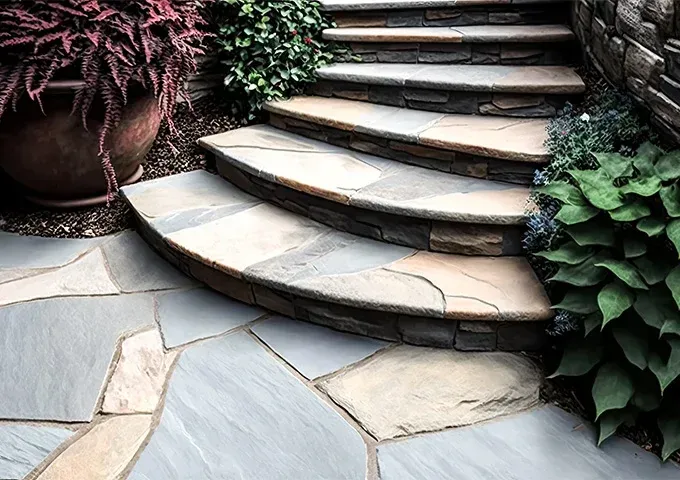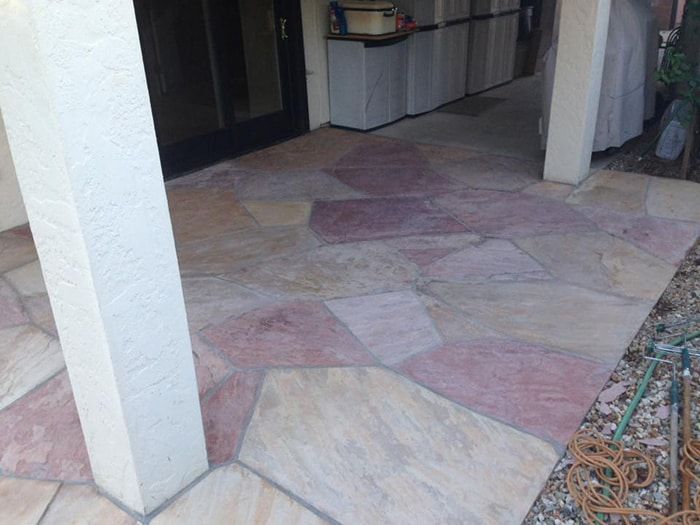Professional Flagstone Restoration and Cleaning Services
Rejuvenating and maintaining the natural beauty of your flagstone surfaces.
What Is Flagstone?
“Flagstone” is not one specific type of stone, but rather the style or pattern of a particular installation. Stones that are most commonly cut into flagstones include slate, bluestone, quartzite, limestone, or sandstone. The flagstones themselves are generally between 3/8” and 1” in thickness and come in cleft and honed finishes.
Flagstones are generally durable, but some stones are harder than others.
Our technicians are experts in various types of stone. They can help you choose, install, and maintain your flagstone surfaces. Their knowledge makes them the ideal choice for this job.
Flagstone Cleaning
A professional should clean the flagstone. Make sure to remove any dry dirt, dust, and debris before starting the cleaning process. Once the surface is free of dust and debris, you can begin cleaning the Flagstone thoroughly.
Flagstone Sealing
The porosity of Flagstone makes this natural stone highly susceptible to staining. Flagstone is extremely porous and requires a suitable sealant to protect it from permanent damage. The key to effectively protecting Flagstone with a sealant is dwell time. There must be adequate penetration for the sealant to work properly.
Flagstone Polishing
Flagstone is difficult to polish, so use a breathable topcoat and specialized polishing compounds for best results.
Contact Marble Stone Polish For A Professional Cleaning or Restoration!
Flagstone Restoration
Flagstone is a type of natural stone frequently used in outdoor building and landscaping projects. Allowing Flagstone to "ventilate," in other words, routine air flow is required. Flagstone and similar substances are porous. They need to release humidity and gases to last a long time.
Applying specific topcoats to Flagstone could obstruct its natural exposure and hinder the stone's ability to breathe effectively. This could result in problems like accumulation of moisture, proliferation of mold, and gradual degradation of the stone. To avert these issues, it's crucial to refrain from using topcoats that entirely seal the stone.
To restore flagstone, first remove the seal that is blocking its ability to breathe.
Flagstone can be restored by removing a seal that blocks its pores. This can be done through honing or sandblasting. Honing grinds the surface to reveal the stone's texture. Sandblasting uses high-powered sand to strip away the seal and restore the stone's natural appearance.
Both methods effectively remove the seal and restore the stone's original look. Both honing and sandblasting effectively remove the seal and bring back the stone's original look.
By letting Flagstone breathe and preserving its natural condition, you can guarantee its well-maintained state and sustained attractiveness for several years ahead.
Would you like the professionals to take a look?
Flagstone Stripping
Flagstone, a naturally occurring stone recognized for its sturdiness and aesthetic appeal, is often utilized in outdoor flooring and landscaping. It's a favored material for constructing patios, pathways, and other exterior areas. However, it is crucial to mention that flagstone should not be sealed or coated with a layer that hinders adequate air circulation.
Applying unsuitable coatings on flagstone can lead to problems such as color changes, flaking, and impeded stone ventilation. In these scenarios, Marble Stone Polish can be effectively and safely employed to strip these waxes or varnishes by eradicating the coverings from the surface. This procedure assists in reviving the flagstone's innate beauty and facilitates proper ventilation, thus guaranteeing its robustness and endurance in outdoor conditions.
Following the right maintenance and care instructions for flagstone is crucial for its lasting beauty and durability. This means steering clear of inappropriate topcoats and utilizing products such as Marble Stone Polish as required to remove any unwanted coatings. With proper care of your flagstone, you can enjoy its natural elegance for an extended period.




